| The base model of this gun is going to be what you find in most of the big box stores with the Redi-Pak, and online. Traditions has them right now for $269 without the Redi-Pak. I don’t think the Redi-Pak is required for this gun because the included tools are mostly for roundball guns. The PA Pellet is very different from a traditional flintlock. This one, also made by Traditions, is called the Pennsylvania model. The sights on the PA Pellet are high quality fiber optic and made of steel for durability in the field. The lock with a fresh new flint tightened in it. This is larger than the flints that are shipped by Traditions these days. The directions that come with the gun ask you to install the flint close to the frizzen, like 1/16th of an inch, but the shorter flints won’t come anywhere near that far. The PA Pellet came in only a little off the perfect zero for point blank shooting out to 150 yards. This three shot group is probably not the best it can do and is just under 3” at 50 yards. The two closer shots are less than 2” apart, which is probably more indicative of the true accuracy. You don’t need a ball starter with these modern plastic sabotted bullets. I found this Barnes tool that screws on the end of your ram rod to perfectly align the bullet in the bottom of the chamber for optimal accuracy. In order to get the Triple Se7en pellets to ignite reliably with the side facing flashhole, I had to stuff the hole with my FFFFG Goex extra fine priming powder. Black powder is extremely corrosive, but I could not find an alternative for priming this gun that would fire the main charge reliably. The natural special selected hardwood version of this gun is gorgeous and I think the traditional look is in the spirit of the special hunt in Pennsylvania. It has the 150grain rating, high end sights, and easy to clean breechplug, so you lose nothing while retaining the most important features. With three 50 grain Triple Se7en pellets, for a total of 150 grain, I was able to get a consistent 1950 fps from the 250 grain Hornady SST sabotted bullets I used. The ballistics are impressive out past 150 yards. The breechplug removes with a standard Allen wrench that comes with the gun, and to re-install it, you have to start with the lines on the side lined up. Learn this now if you are buying the rifle and are a manual reader. It will save you twenty minutes of standing there shaking your head I swabbed the barrel between every shot and the Triple Se7en left very little residue, and what there was stays very soft and is easy to remove. Make sure you remove the two side screws and remove the entire lock assembly for cleaning. I don’t disassemble it further than this and I scrub it with soapy water and a toothbrush or other soft bristle brush, using dish soap. Because the priming powder is straight real black powder, I strongly suggest soaking the plug as well, and working over the flash hole with a pipe cleaner. If you can’t get a pipe cleaner from a smoke shop, Bass Pro has them on the shelf in the muzzleloading department. Taking a deer with a flintlock is one of those experiences that a real hunter treasures and will remember and talk about for the rest of his or her life. This is a Lucite encased bullet my father made after taking a large buck with a flintlock back in the 1970s. The mini-ball is a Civil War era bullet that expands at the base to engage the rifling in a muzzleloading firearm. The modern plastic sabot is far superior in both ballistics and accuracy. |
Traditions Performance Firearms
https://www.traditionsfirearms.com/
Join Traditions on Facebook:
https://www.facebook.com/TraditionsPerformanceFirearms
Many of us long for the days when technology didn’t rule our lives, yet we love the convenience of it. It’s the same thing with special muzzleloader seasons for whitetail. The antiquity of the technology is romantic, but better ballistics, better sights, and easier and more consistent components can make a hunt more likely to put a rack on the wall and fill a freezer with meat. The precious time we manage to actually get out into the woods in our busy lives is valuable, and going into the woods with a better gun during muzzleloader season has become the norm instead of the exception.
Traditions Performance Firearms makes some of the best values in what are called the “modern muzzleloader.” These are guns that are legal for the special muzzleloader seasons, but have special features that make them fire more reliably, deliver better accuracy, and provide for easier cleanup. Flintlocks, the most primitive of American firearm technology, are not new to Traditions. Their “Deer Hunter” series can be found in just about every big box store in America, and in many gun dealers of course. But because there are so many hunters who take advantage of the special late season, flintlock only deer hunt in Pennsylvania, they have created a new series of flintlocks “a cut above” the Deer Hunter series, with advanced features and finishes at an extremely reasonable price.
The PA Pellet Flintlock is Pennsylvania legal for the hunt, which happens Dec. 26-Jan. 28 this year, and it incorporates as many modern conveniences as legally possible while retaining the traditional qualities that the rules for the season demand. Pennsylvania offers this hunt because of the rich flintlock tradition in the state. Many rifle makers of the 18th and early 19th century were based in Pennslyvania, and perhaps the most common name for a long flintlock rifle is the “Pennylvania Rifle.” If you are a fan of the Revolutionary War, or you just want to take that second antler-less deer for winter meat, this gun makes managing an old and cantankerous technology much easier. It actually works really well.
A flintlock fires its bullet using a real piece of flintstone which is struck on a piece of steel. The flint is held in the hammer of the gun by jaw device called, coincidentally, a jaw. When you pull the trigger, the hammer and the flint come down on a piece of steel, called a frizzen. This produces sparks, and the sparks ignite a little pile of gunpowder in a pan, which is coincidentally called, a pan.
A hole in the side of the chamber is located right next to the pan. Igniting the powder forces flames and heat into the hole and into the breech, igniting the main charge, which fires the bullet. The result is that you have a three step firing sequence. Pull the trigger, click, poof, bang.
I wish I could say that firing a flintlock is easy, but I have always found it a little troubling. Don’t get me wrong, it’s well worth the challenges. I love flintlocks. But being able to hold the rifle on target through the poof phase of the shot is really hard. I have never been able to make a reliable game shot at more than 50 yards, even with an accurate rifle. Maybe I use too much powder in my pan, but the poof really flusters me. It is a gunpowder fire right in your face, and firearm technology did abandon the flintlock very quickly once the percussion cap was developed. They are a lot of fun to shoot, with safety glasses, even in the field, but the flintlock was definitely left behind for a reason.
The PA Pellet Flintlock incorporates all of the conveniences that Traditions brings to their inline muzzleloaders, including the use of pellet gunpowder and the ability to use plastic sheath sabotted bullets. The twist is 1 in 48”, which is faster than a traditional roundball muzzleloader that generally has a 1 in 66” twist. And it employs the Traditions Accelerator(tm) breechplug, which is a direct line system. Usually a flintlock uses a wormhole design to reach the powder, but with the PA Pellet, the flame from the pan is forced directly in line to the back of the powder charge. The Accelerator(tm) breechplug unscrews easily for cleaning as well.
In anything with a lot of rules, there is the letter of the law and the spirit of the law. The letter of the law in Pennsylvania says that the rifle must be an original or a “similar reproduction of muzzle loading firearm manufactured prior to 1800. “ It also specifies that you may not use optical sights, and that the gun must use a natural stone and be of the flintlock type.
From there it is a matter of preference as to just how modern you want to get. The rules specifically forbid optical sights, scopes, but Traditions has deemed any other modern open sights legal, and Pennsylvania seems to agree with them. The PA Pellet comes with Williams fiber optic metal sights, which are extremely high quality, very usable, and bright in even low light conditions. They are a significant upgrade from the sights on the Deer Hunter series. The deer are moving at dusk and dawn, and being able to see your sights can make a big difference.
For finishes, the PA Pellet does come in a natural selected hardwood, but as you can see from our review gun, it also comes in a soft touch Mossy Oak Treestand(tm), as well as a synthetic black stocked model. The barrels can also be traditional blued, as well as camo, and the Traditions application of CeraKote which is several times more durable and rust resistant than stainless steel. I don’t know how that fits into the “similar reproduction” part of the law, but nobody seems to care. Theoretically I’m sure some people in the 1700s did in some way camouflage their firearm, and the stock being plastic doesn’t add any competitive advantage to the gun, so Pennsylvania fish and game doesn’t seem to mind.
Personally, although I haven’t held the wooden one, I think the wood stocked version is the biggest score of the lot. I’m a traditional guy and when it comes to flintlocks, I generally prefer the spirit, and not the letter of the law. But even from a traditional perspective, you can’t beat the sights and easy cleaning of the PA Pellet, and I don’t know that even a hardcore traditionalist would throw stones at the ballistic advantage when it comes to humane shots on big game. With the natural wood gun, you can have the feel of a traditional gun, but with the benefits of a modern muzzleloader. If you aren’t a traditionalist, you’d probably prefer the soft touch camo versions.
Our review gun was the flagship model, with the Mossy Oak stock and silver colored CeraKote barrel. Its soft touch stock is amazing. You feel like you are holding a gun easily twice as expensive, and the alignment of the recoil pad and components is flawless. Traditions makes their guns in Spain and the workmanship and attention to detail is superb. As Traditions says in their marketing material, you really can feel the difference.
I have owned and shot the long traditional Pennsylvania Model from Traditions for many years. I even stuffed loose powder and round balls into this gun at first to see how it shot, before moving on to the “modern” ammo. Being traditional by nature, I assumed that the modern components were not as good and were merely made for people too lazy to use the real stuff. How wrong I was.
Power
When it comes right down to it, I don’t know that I would be comfortable shooting a deer with my standard Pennsylvania roundball gun now that I think about it. I am sure plenty of deer have been taken with them over the years, and with even lesser weapons. In a treestand, with the deer coming in to 20 yards or less away, maybe. With a muzzleloader, and especially a flintlock, you only get one shot, and if that doesn’t down the deer, it’s blood trail duty for Mr. Hunter. Nobody likes blood trail duty, both because you feel bad for the wounded animal and because it is a lot of hoofing you didn’t sign up for.
You can’t use the plastic sabot bullets with a traditional 1 in 66” twist muzzleloader. That rifling twist is made for a patched pure lead .490 diameter roundball that weighs about 180 grains. This is a significant ballistic disadvantage compared to the PA Pellet that can accommodate a much heavier and specialized plastic sabotted bullet made for big game. And to my surprise, that isn’t the only significant ballistic disadvantage.
The PA Pellet has a 150 grain powder capability, and for those hard core black powder guys out there giggling to yourself, hold up a second. Conventional black powder thinking is that the average powder charge for any given load is generally going to max out somewhere around 1 ½ times the bore diameter, assuming that you have a barrel of sufficient length within normal firearm standards. More powder than that is generally thought to be pointless, because black powder burns so slowly compared to smokeless that you can’t burn more than that before the bullet leaves the barrel. So for a 50 caliber muzzleloader, conventional black powder thinking is that any more than 75 grains or so and you are just wasting your time, wasting powder, and creating an unnecessarily big muzzle flash.
Not so with the PA Pellet. I shot it using Triple Se7en Pellets at 50 grains each. One pellet produced an average of 950 feet per second with the 250 grain Hornady 45 caliber SST sabots. That’s a little better than a 44 mag, and a respectable number for whitetails in the dense forests of the northeast. When I moved up to two pellets, 100 grains, the velocity moved up to 1250 feet per second. Great! But I figured that was the end of the line. I thought the second pellet was already probably burning partially outside of the barrel and a third pellet was just going to be more of the same, creating a big fiery bang but not a lot more velocity.
When I shot it and clocked that three pellet, 150 grain charge at no less than 1950 feet per second, I was shocked. Clearly, the Triple Se7en propellant and the 250 grain bullet are combining for ballistics thought to be outside of standard muzzleloader range. That is just over the ballistic performance of a .454 Casull, and in excess of a standard .45-70, just shy of a .444 Marlin. The Hornady website for this bullet actually lists the 150 grain charge as being the standard, and the numbers really do prove out on the chronograph. You’ll never get those kinds of numbers out of a roundball gun, even with mini-balls (those civil war style bullets).
Accuracy
If you look at the target in the pictures here, I was able to shoot 3 rounds into less than 3 inches at 50 yards. Those were full snot 150 grain loads. The recoil is heavy, but manageable, and loaded up like that the gun does jump significantly. But considering that your follow-up shot is going to take you a good couple of minutes to load, shot-to-shot recovery isn’t much of an issue.
For the record, I haven’t been able to shoot anything close to this with my roundball gun. When you seat a normal roundball in the bore of the rifle, with its patch, you have to dent it slightly with a bullet starting tool. This makes it slightly oblong, and since it is a hand tool that you are pressing with, the angle of compression is always going to be slightly different. A 1 in 66” twist roundball gun isn’t optimized for accuracy anyway, and the slightly oblong bullets make it hard to keep 3 rounds inside of 6 inches at 50 yards. The PA Pellet, with its 1 in 48” twist, is optimized for the Hornady SST bullets I was using and the accuracy showed it.
Keep in mind, this is not the true accuracy of the gun. As I said, we are talking about a click, poof, bang, and you have to hold the gun steady during the poof, which is that gunpowder fire in front of your face. I don’t feel I do this reliably enough to judge accuracy, but I did shoot this gun better than I have my other flintlocks, so it has to say something for the accuracy of the gun itself. If you plan to shoot the late hunt in Pennsylvania and you are buying your first flintlock, you would be well served to take it out to the range and put some energy into getting used to shooting it. Then, when you use it in the field, definitely try to rest it in a tree or carry cross sticks. And if there is ever a gun you definitely want to wear high quality shooting glasses with in the field, it is the flintlock. I will never get used to that fire in my face.
The gun came out of the box shooting exactly where you see in the target, a few inches high and a couple inches to the left. I didn’t zero the rifle to the target for the pictures for a reason, to show that zeroing the rifle isn’t going to be that much of an issue. Notice that I brought big archery targets to the range with me because I had to shoot without a spotter, and thought it might take me ten shots to get on the paper. I’ve experienced this tendency with many muzzleloaders over the years, mostly from Italian manufacturers. It was really pleasant to see the PA Pellet shoot so close to point of aim right out of the box.
If you look at the ballistics for this load in the chart from the Hornady Ballistics Calculator, the right zero for this load would be about an inch high at 50 yards to zero at 100 yards. If you want to sight in for a 150 yard zero, you do have ballistics for it with the sabot and 150 grains of powder. That would make the 50 yard zero about 3” high, well within the vital zone for a northeast whitetail, and just about where this gun was set when it arrived.
Shooting a Flintlock with Pellets
The most challenging thing about this gun is what is challenging about all flintlocks, and why flintlocks have their own season. They don’t always go off, even under the best circumstances. I wish I could say I have found the secret to flintlocks, but really, sometimes flintlocks behave, and sometimes they give you fits.
They key to a flintlock is its flint. There are a number of YouTube videos on how to “knap” your own flints, but I don’t even know where you would find the big flint stones to make them from. We for sure don’t have them on the side of the road in Florida. Instead I choose to buy my flints, and a number of companies make them, including Traditions, and you should buy some with your rifle. My one criticism of the this gun is that it doesn’t come with a flint, so you not only have to buy one, you have to find a little piece of leather and figure out the best way to mount it in the jaw as well. It would be nice to have the first one mounted correctly from the factory just to see what right looks like. For a new flintlock shooter, it is the kind of thing that you never feel you’re doing right.
I only had one flint for my tests of this gun, but I was able to easily get a reliable spark. It says in the 2001 Traditions Catalog that the new PA Pellet Flintlock has an extra hardened frizzen, which I assume is a good trait, and I assume it is an improvement over the Deer Hunter series. I have never had a problem getting a spark from a newly purchased flint on my Pennsylvania model regardless. You generally can count on about 20 shots from a store bought flint before you have to start adjusting it, and that certainly isn’t something you want to do in the field. There is nothing worse than click… nothing, cock it again, click … nothing, when you expect click, poof, bang. Before you go into the field, buy new flints and install one, then snap it a few times with no powder to make sure you have a healthy spark and that it is landing in the pan.
I found that you really have to find some FFFFG (that’s 4 Fs) extra fine Goex black powder to fire pellets reliably in this gun. I tried to prime the pan with loose Triple Se7en FFFG and it didn’t work, even when I rammed the powder into the flash hole. Fortunately, if you are going hunting in Pennsylvania, this isn’t something you are going to have to try to order online with an extra hazardous materials charge. Most of the gun shops in the state have a good supply of black powder. Many gun shops in the northeast, in fact, like my favorite gun shop Kittery Trading Post also carry FFFFG black powder.
Something I haven’t tried, but have read about online, is to use a fine mesh to filter your own FFFFG black powder from FFFG Goex (Swiss is too consistent for this). It’s an idea anyway, you might try it. Something else I haven’t tried is to put some FFFG in a film canister with a marble and crush it up. But who has film canisters or marbles these days anyway? Can you do it with a Wii or an Xbox?
I did have to stuff the FFFFG Goex into the flash hole with a pipe cleaner to get the pellets to ignite reliably. In the field I would do this even with loose powder if you aren’t using pellets as the main charge. A little insurance doesn’t hurt. Once I figured out the system of using FFFFG Goex and stuffing the flash hole, the pellets ignited reliably every time.
Cleaning a Flintlock
I would be remiss if I didn’t include a brief section on cleaning flintlocks because this is the kind of thing where if you don’t clean it right once, your gun is ruined for good. If you don’t already know this, you can’t just swab the bore with a wet patch on any muzzleloader. The gun has to be taken apart and the metal components washed out good with soapy water. They aren’t like a regular rifle where both ends of the barrel are open and you insert a cartridge. One end is closed on a muzzleloader. You have to remove the barrel from the gun, and then unscrew the breechplug. Traditions has an added convenience even over other inline plugs. Rather than rely on torque for a good fit, they rely on a rubber O-ring, and they are the easiest muzzleloaders I have ever taken apart and cleaned.
The lock also needs to be scrubbed out really well with soapy water. It removes easily by removing two screws. I use a toothbrush or one of the plastic bore brushes that come with many pistols these days. You can then just let the lock dry, or put it in the oven to dry it out if you’re concerned about rust. There will also be powder and burns on the stock. Clean these to the best of your ability, but stock burns are just part of owning and shooting a flintlock. They are usually never perfect again after that first shot.
One thing to be aware of is that after you clean the gun, don’t leave a lot of oil in the bottom of the breech. If there is any standing oil and you drop a charge in, pellet or loose, the oil can make the powder inert and you’ll end up with click, poof, nothing. On cap & ball guns we generally fire a dry cap before putting in a charge, just to dry out any oil, but with a flintlock, where one priming charge makes the lock dirty and prone to rust (because you have to use real black powder which is highly corrosive), I don’t suggest it.
Stuff You Need
As I said, Traditions doesn’t at present ship their flintlocks with a flint, so if you are buying the gun online, keep in mind that you are going to have to order the flints separately. You also need a little piece of leather to hold the flint in the jaws. You will have to buy loose powder or pellets for the main charge and for that I strongly suggest Hodgdon Triple Se7en. It has much better performance than either real black powder or Pyrodex, and is less corrosive than both, if it is corrosive at all. You will still need some FFFFG Goex black powder for the flash pan. If you need to buy it online, I have always ordered from Powder Inc. You do have to pay the hazmat fee, even on small shipments. One pound of FFFFG black powder will last you for years in a flintlock pan.
Traditions sells this gun in a plastic bubble pack with their Redi-Pak, but only the black stocked version with the blued barrel. The Redi-Pak includes bullets, ball/patch puller, .50 cal jag/loading tip, round ball starter, cleaning patches, flintlock pan primer, universal fast loader, cleaning pick, powder measure, breech plug/nipple lube, EZ clean bore solvent, and a How To Load, Shoot, & Clean Your Muzzleloader DVD. It is everything you need to start muzzleloading with the exception of the two powders you need, and flints.
Unless you specifically want the black version of this gun with the blued barrel, however, I wouldn’t buy it with Redi-Pak. The black version is significantly cheaper regardless, so you may want that one, but most of the accessories in the Redi-Pak don’t apply to this specific gun. The PA Pellet shoots roundballs fine, but not with pellet powder, and most of the accessories it comes with are really meant for roundball guns using loose powder, and some, like the patch and bullet pullers, are made for guns that don’t have an easily removable breechplug. The plastic sabot slugs don’t need a starter, they thumb press in easily. On the other hand, there are also some Traditions cleaning products in the Redi-Pak so, combined with the free bullets, it’s not a bad deal if you do happen to want the black rifle.
Some people refuse to believe that soapy water is the best thing for black powder firearms so they insist on buying a cleaning solution. To each his own, but dish soap works great. I did buy the Traditions pre-wet patches to take to the range with this gun because they are just the right size and very convenient. The pan primer is also useful, and is not an inexpensive accessory.
The Traditions PA Pellet Flintlock is a gun you can actually buy online and have shipped to your door in most locations. If you want the higher end configurations, you may have to order it directly from Traditions. I looked around at the usual online retailers for hunting and shooting equipment and none of them even list the Cerakote version of the gun, let alone the soft touch camo ones. Don’t settle for the black one in the bubble pack if that’s all your local big box store has and you really want the nicer ones. The Traditions phone number is 860-388-4656, and the guns are available on their website.
From what I’m told, there’s nothing like taking a deer with a flintlock. You get one shot, and that shot is not an easy thing to keep on target while you wait for it to go off. Four hundred years disappear behind you and there you are, standing with the founders of this country with a successful hunt and winter meat for the family. I don’t remember the details, but my father hunted with a flintlock in upstate New Hampshire when I was growing up. He shot miniballs in it with great success and I still have a bullet encased in lucite from one of his deer. It’s truly an achievement to shoot a deer the way they were shot before America even existed as a country, and there are few feelings like traipsing through the woods in the late fall with a the same rifle used by the pioneers. Traditions has brought the flintlock rifle to a whole new level with the PA Pellet, and if the flintlock is something you have always wanted to try, this would be the no risk approach. It works great. For hunting in Pennsylvania, it could bag you that end-of-the-season deer that everyone else missed in December.
Traditions Performance Firearms
https://www.traditionsfirearms.com/
Join Traditions on Facebook:
https://www.facebook.com/TraditionsPerformanceFirearms



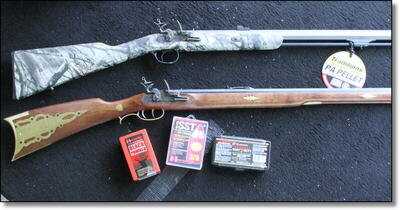

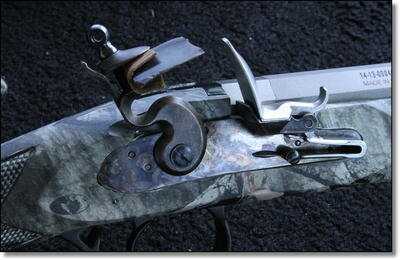
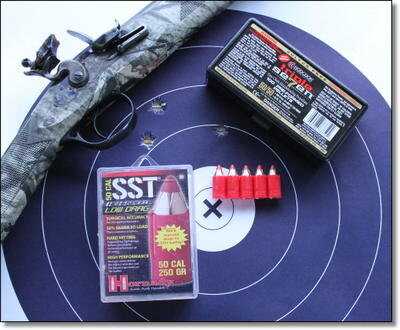



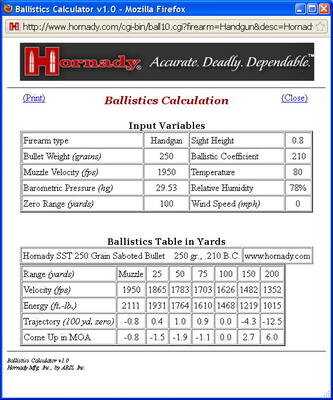
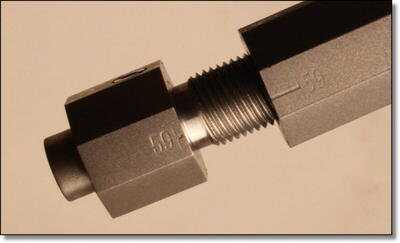


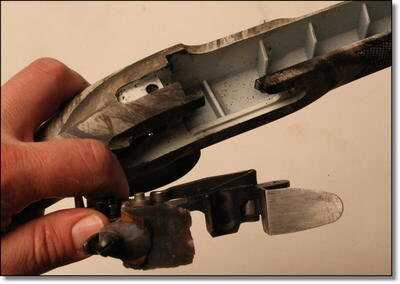

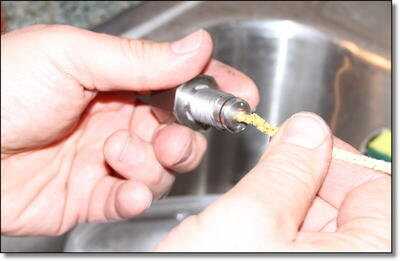
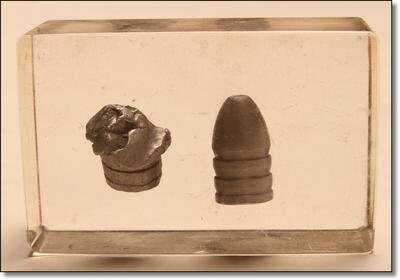
Where is Sam Fadala when you need him ? This writer obviously has little or no experience with flintlocks, and his comparative ballistic calculations shows that he has a great deal to learn !
i own one of these guns and my only comment is dont use 2 f powder it isnt reliable Iuse 3 f in the barrel and 4 f in the pan shooting balls
I don’t know where you got the idea that flintlocks are not accurate. I personally own 4 of em and I know that they quite capable of putting a ball through the same hole at 50 yards as long as I do my part. Muzzleloaders can be finicky beasts at times so the proper load has to be worked up for the individual rifle. Example is a 50 cal double rifle I own likes 65 grains of 3f in the right barrel and 70 grains in the left. Otherwise it shoots all over the place. The author of this article needs to spend some time practicing with his flinter and getting over the flinch from the flash. Also the idea of using 3 pellets of 3 7 may not be the best or most accurate load for the rifle. While pellets are fast and convenient to load you still may be short changing yourself as to the rifles true potential.
I do not own a flintlock rifle your article was helpful and informative as I am trying to decide if I want a flinter or percussion muzzle loader. Thank You. I did notice however that your article did bring out the usual number of snobs and blowhards found in each and every sport and each and every blog telling you and all how much better at anything they are.
lets not fight about what work till you find what work for you Iam 64 been using only flint locks since I was 1 6 years old. always use according to the cal. .50 = 60 grains x3 powder. round ball 180 = dead deer. Boys I get my limit every year. during reg gun season I still use my flintster. hunters are aways looking for a path to fallow, I say make yours.
These guns will reliably ignite pellets but you have to do the accelerator trick mentioned by J. Rachael above. The pan ignition has to make it in through the hole about 3/8″ then make a hard 90 degree turn then continue up a small tube for about 1 1/2″ before it reaches the base of the pellets. It only takes a few grains, usually 5 or less, to assist the pan in getting to the base of the pellets. Think of it as a system with three powders. Without this additional charge I have had mine go off but sometimes I have to prime the pan again and fire a second time in about 50% of my attempts. Obviously that doesn’t work while in the woods. Also
Read your review…Thank you…where did you get the longer flints?…it sounds like the ones Tradtions sells won’t work…Jeff
You guys have made a lot of misstatements about traditional muzzleloaders and accuracy, so I would like to challenge you and the shooters of your choice to join us at Jefferson Co. Longrifles (Brookville, PA) for a little shoot off. Trail, Mountain Man, 25,50 & 100 yds paper. A man that can’t manage less than 6″ group (offhand) at 50 yards isn’t much of a shot. Bring your pellet firing flintlocks on, and prove your hype. The ball is in your court, you have my e-mail….we will set a date-
It looks to me as though “normal” pan priming (as described in the replies above) might work poorly in this design for two reasons. One is the black powder substitute high ignition point, the other is the right angle turn the flash must apparently make to find the main charge. Typical side locks of the percussion variety have this issue and it sometimes causes hang-fires or misfires even though they have the advantage of a relatively high pressure jet of flame to start ignition. Saddleing a flintlock with this added challenge doesn’t seem too smart. As far as the maximum load issue goes, the chronograph tells the story, and heavy bullets plus 777 must make for a high pressure and fairly efficient burn. Many Happy Returns of the Day, VOS PS A good traditional flintlock, well loaded, will shoot quicker and more accurately than demonstrated here. If you master follow through with a flintlock, you sure won’t jerk your modern rifle or shotgun off target!
I’ve spent many a weekend target shooting with a Hawkin’s 50 cal Black power Flintlock rifle.
As far as turning Goex Black powder from FFFX into FFFFX I met a old timer, “Now I am one” at a Rendezvous back in the 1980’s who showed me how to use two table spoons, Spooning together opposite of how they sit in a drawer holding each handle in a different hand to get a finer than FFFX power that I’ve found to be reliable for ignition.
Since I use Goex FFFX Powder only, in a couple of different grain loadings for my pleasure shooting,
This get’s rid of the need of having to buy and keep two cans of different grades of black powder.
Just thought I would pass this on to others to give it a try.
Laurence Segal
Very much enjoyed the article and the comments. Thanks
Never used a flintlock, gotta try it. Had a T/C 54 and with round I used 80 and for the bullet I cast I used up to 120! More that than gave no difference, so I figured it was just blowing out or sitting at the botton, which tends to make things not work as good…Love the suggestions, now I have to locate a decent rifle close by…
The problem with trying to combine modern technology in an antiquated system is that you have to think outside the box to get it to work better than its’ design was originally capable of. In this case, your compressed pellets are designed for use with shotgun primers, therefore, trying to ignite them with ancient 4F powder is going to give you fits, as you have found out. As stated by the others, packing the flash hole with 4F creates a slow-burning fuse, which is the reason for the delay in firing. I’m going to recommend you heed the advice of the others on using a proper sized flint, adjusted as described, and do not overfill the pan – these guys are right on about this – a few centuries back, this was common knowledge for anyone who used a flintlock, so why try to reinvent the process that had already been perfected by trial and error back when the flintlock was the state of the art? Now for the pellets – with an inline, using shotgun primers, you might be able to get a relatively efficient burn using a maximum charge due to the intensity of the flame that is produced. With a flintlock, your ignition source is much less intense, and therefore will be working at a considerable disadvantage to get the 777 pellets to ignite, much less, to get them to fully combust before your bullet exits the muzzle. Basically, whatever propellant has not combusted inside the barrel, is wasted – makes sense, right? I would recommend you try backing off of your maximum load to see if you can find the optimum load for your gun – it might be two 50 grain pellets, or maybe a combination of the different sizes that are available that will put you somewhere between 100 grains and your 150 grain maximum load. And, in order to get the pellets to ignite faster, you might try an accelerator – basically a booster charge of 2F or 3F black powder that you would dump in prior to inserting your pellets. Start with 5 grains (by volume), and see how that works for you – increase it some if needed, but make sure that your charge does not exceed the maximum load for your gun with all combined components. As you said in the article, you are going to have to clean the thing anyway because you are using black powder in the pan to get it to go off, so might as well discard that benefit of the 777 from the get-go – the only real benefit you are getting, is a potential increase in velocity. And if you compare the differences in velocity between going with straight black powder for the whole enchilada, and doing all of this wizardry to make the thing work reliably with the 777 pellets, you might find yourself asking “is this really worth all of the extra effort?” Good luck!
Honestly, the writer of the article knows nothing about flintlocks much less how to shoot them. All my flintlocks, except my smoothbore, will shoot one inch groups at 50 yards (5 shot) if I do my part. I’ve also killed deer past 100 yards with two of my rifles using patched round ball that I cast myself. If you know anything about them at all, you will have no problems with reliability. I’ve taken many deer with various flintlocks and all were one shot kills. Black powder is the only way to go. Using only 100 grains of Goes 3F in my .50 yields 2080fps with a 180 grain lead ball. All this with primitive sights that are a bit challenging to use. Flints? It’s not unusual for me (and others) to get around 100 or more shots from a single flint. Why complicate a tried and true system with “iffy” modern tricks that are basically slow and unreliable. Learn some things and then get a life.
I can see why the writer has problems firing a flintlock. He doesn’t know what the heck he’s doing.
1. Do NOT, I say again, do NOT fill the touch-hole with powder! That slows the process and is the reason for the lag between the flash (“poof”) and bang! When the touch-hole is full, it acts like a fuse and the fire has to burn through – and loses some heat as a result due to the time it takes to make the slower burn.
2. YES – he is putting too much powder in the pan. We want FLASH to go through the touch-hole – not powder. About half a pan and NOT full up against the touch-hole gives much better results. A properly primed flintlock should have the main charge firing almost simultaneously with the flash in the pan – no lag. Over-filling the pan slows things down.
3. You want the flint to be of a length that will be pointing directly into the center of the pan when in the fired position. It needs to hit the steel/frizzen at an angle so that it will carve small bits of metal and not shatter the flint – which is what will happen if it hits the steel straight on. You want it to direct the sparks into the pan and lining it up so that it’s pointing into the center of the pan at the end of the fall is the best way to ensure that result.
Been shooting flinters since the late ’60s in reenactments and competitions. I’ve learned a bit about them in that time. A properly tuned flintlock with a good flint and the PROPER powder charge and priming should fire as fast as a cartridge firearm. Click/BANG! Don’t over-stuff it! You’ll also find that “less is more” works with black powder. Too much in the main charge can reduce accuracy and wastes powder as it doesn’t all burn on firing and a lot of unburned powder goes out the muzzle. You get a nice “fire and brimstone” effect of flash and smoke, but less effective ballistics. The groups displayed are not good at all for a properly loaded, aimed, and fired weapon. Good hunting!
I was hoping we would get some comments like these. You can’t be an expert on everything and these are great tips. The issue with the stuffing the flash hole is that you have to ignite Triple Se7en pellets, and try as I might, it just wasn’t happening with FFFFG Goex in just the pan. They are meant for shotgun primers. I did get a fairly reliable ignition with loose Triple Se7en without stuffing the hole, but there was still a significant delay.
I feel that the point of this gun is to allow the casual shooter/hunter to go into the woods in December and try for that second or even first deer that everyone else missed. It isn’t a product for the guy like you who takes a genuine love for the flintlock and experiments with different loads and pan loading ideas until you get something that always works. If you are going to shoot Triple Se7en, which from my experience gives you almost twice the velocity of black powder with no mess and no rust if you miss a spot, my advice with this gun for the casual shooter is sit in a tree stand with the gun rested and stuff the hole.
The manual says to stuff the hole with 4444F to fire pellets.
Even the manufacturer says to stuff the touch hole when using PELLETS!
I bet this rifle is capable of better accuracy than what you report. If it’s not, there is little point in using 150 grains of powder; you will have to get within 50 yards of your quarry, and the rifle will be much cheaper and more pleasant to shoot with lighter powder charges. If you experience a perceptible delay between hammer release and discharge, I wager there is something you could be doing better; for one thing the flint pictured is far too big for this lock. A musket-size flint in this small lock risks hitting the barrel and/or the bottom of the pan, and a flint of the proper size will probably strike better sparks. A 5/8″ flint will probably work much better. Any granulation of real black powder (at least 4F, 3F, and 2F) will work OK for priming, and it does not need to be ground or sifted.